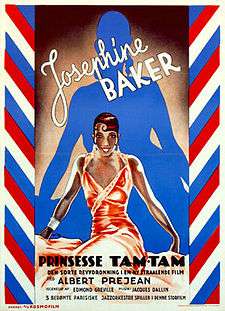Princesse Tam-Tam
| Princesse Tam-Tam | |
|---|---|
|
Danish film poster | |
| Directed by | Edmond T. Gréville |
| Produced by | Arys Nissotti |
| Written by |
Pepito Abatino Yves Mirande |
| Starring |
Josephine Baker Albert Préjean |
| Music by | Jacques Dallin |
| Cinematography | Georges Benoît |
| Edited by | Jean Feyte |
Release dates | 2 November 1935 (France) |
Running time | 77 minutes |
| Language | French |
Princesse Tam-Tam is a 1935 French black-and-white film which stars Josephine Baker as a local Tunisian girl who is educated and then introduced to Parisian high society.[1] Baker sings two songs, "Dream Ship" and "Neath the Tropical Blue Skies", in the film, and dances a number of times.
Plot
Max de Mirecourt (Albert Préjean), a frustrated writer, goes to Tunisia in search of inspiration for his next novel. He meets a local girl named Alwina (Josephine Baker) whose personality intrigues Max so greatly that he invents a character based on her for his newest (and 'most exciting') novel. His relation with Alwina serves a dual purpose in that it also angers (or at least highly annoys) his wife Lucie (Germaine Aussey) who has been flirting with the Maharaja of Datane (Jean Galland) back in Paris. Alwina is taken under Max's wing and taught the manners and social graces of a high society princess. She is then whisked away to Paris with Max and pretends to be Princess Tam Tam, from far away Africa.
Lucie is further enraged by all the attention that Alwina receives and, after her friend sees Alwina dance provocatively in a sailor's bar, calls upon her Maharaja to craft a plan which will destroy her husband's relation with "the princess." The Maharaja throws a grand party, inviting the upper crust of Parisian society. Alwina is unable to resist the exotic music, and promptly joins the large, staged dance number, embarrassing Max – until he realizes that the entire audience is on their feet, applauding Alwina. Lucie is furious.
Lucie and Max forgive each other in the end and fall in love again, Alwina returns to Tunisia after the frustrating realization that, as the Maharaja puts it, "Some windows face to the West, and the others to the East." Ultimately, however, the entire European affair is revealed to be little more than an enactment of Max's novel in progress. Alwina never does go to Europe, and the primary events of the film are simply a staging of how Max has imagined them. Alwina is given Max's Tunisian estate, and Max's new novel is a success. The title of his new work is "Civilisation." When asked about Alwina while back in Europe, Max states that she is "Better where she is."
The film closes with a scene of Alwina and Dar back in Tunisia, with a newborn child, and with farm animals now strewn about Max's mansion. In the final shot, a donkey eats the title page of "Civilisation" from off of Max's (now Alwina's) floor.
Cast
- Josephine Baker as Alwina
- Albert Préjean as Max de Mirecourt
- Robert Arnoux as Coton
- Germaine Aussey as Lucie de Mirecourt
- Georges Péclet as Dar
- Viviane Romance as Lucie's Friend
- Jean Galland as Maharajah of Datane
Cast note:
- The Comedian Harmonists, a sought-after German act which was later disbanded by the government of Nazi Germany, due to three of its members being Jewish, provided backup singing for the production number.[2]
Production
The African scenes in Princesse Tam-Tam were filmed on location in Tunisia.[2] The Eastman House restored the film in 1989.[2]
Reception
Although the film had a premiere in New York City, the Hollywood censors of the Hays Office refused to pass the film, which prevented it from being shown in the most theatres in rest of the country, although it did play independent theatres which catered to African-American audiences.[2]
Poster
On 4 February 2010, Swann Galleries set an auction record for Svend Koppel’s poster for the film at $9,000. The image, "Josephine Baker / Prinsesse Tam-Tam", from 1935, was later used by the United States Postal Service on a postage stamp.[3]
References
Notes
